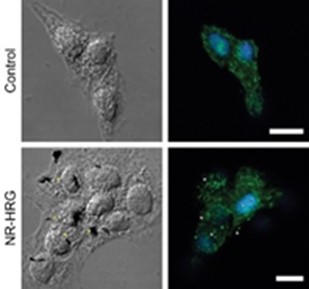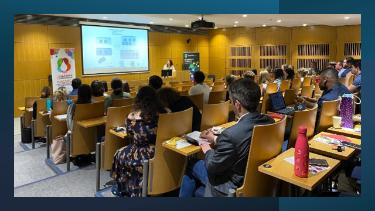How nanotechnology is being used to tackle cancer and other stories from our latest publications
Nanoscience is recognised as an emerging science of objects that have at least one dimension ranging from a few nanometers to less than 100 nm. Through the manipulation of organic and inorganic materials at the atomic level, novel materials can be prepared with different thermal, optical, electrical, and mechanical properties, compared to the bulk state of the same materials.
Application of these nanomaterials shows particular promise in medical applications, where nanostructures are engineered to serve as devices for sensing, targeting, delivering, and imaging biological structures. The nanoscale offers a number of advantages - for applications in medicine and in biology, nanosystems can be designed to interact with cells and tissues at a molecular level with a high degree of functional specificity including novel drug delivery systems, contrast agents, and tissue engineering among others.
In two recently published collaborative studies, Gil Lee’s Bionanosciences Laboratory at the UCD Conway Institute together with collaborators at UCD School of Physics, Trinity College Dublin, University of Bahrain, and SBI researchers Alex von Kriegsheim and Walter Kolch, used multifunctional nanoparticles to target tumour cells.

Figure: ErbB2 receptor clustering upon HRG–nanorod binding to MCF7 cells. Confocal micrographs showing a dorsal section of targeted (bottom panel) and non-targeted (top panel) MCF7 cells. ErbB2 receptors (green) were immunostained without permeabilising the plasma membrane. Nuclei were stained with Hoechst 33342 (blue). Stars indicate examples of ErbB2 receptor clusters that are in close proximity of nanorods.
The team engineered so-called ‘nanorods’, functionalised with the growth factor Heregulin, which would bind to ErbB2/3 receptors at the cell surface of breast cancer cells. Binding of these nanostructures to the surface of cancer cells in combination with Raf inhibitors would lead to the hyperactivation of the MAPK signaling pathway and subsequent death of the tumour cells. These results demonstrate multifunctional nanoparticles that actively target specific cells as promising tools for cancer diagnosis and therapy.
Further information
Mechanochemical Stimulation of MCF7 Cells with Rod-Shaped Fe-Au Janus Particles Induces Cell Death Through Paradoxical Hyperactivation of ERK.
Kilinc D, Lesniak A, Rashdan SA, Gandhi D, Blasiak A, Fannin PC, von Kriegsheim A, Kolch W, Lee GU. Adv Healthc Mater. 2014 Oct 9. PMID: 25296863
In vitro study of the interaction of heregulin-functionalized magnetic-optical nanorods with MCF7 and MDA-MB-231 cells.
Lesniak A, Kilinc D, Rashdan SA, von Kriegsheim A, Ashall B, Zerulla D, Kolch W, Lee GU. Faraday Discuss. 2014 Sep 30. PMID: 25266763
Further articles by SBI researchers on nanoparticles
Physiological Temperature Has a Crucial Role in Amyloid Beta in the Absence and Presence of Hydrophobic and Hydrophilic Nanoparticles.
Ghavami M, Rezaei M, Ejtehadi R, Lotfi M, Shokrgozar MA, Emamy BA, Rauch J, and Mahmoudi M. ACS Chem Neurosci. 2013 Mar 20. PMID: 23509973.
Big Signals from Small Particles: Regulation of Cell Signaling Pathways by Nanoparticles.
Rauch J, Kolch W, Laurent S, Mahmoudi M. Chem Rev. 2013 May 8. PMID: 23428231.
Cell Type-Specific Activation of AKT and ERK Signaling Pathways by Small Negatively-Charged Magnetic Nanoparticles.
Rauch J, Kolch W, Mahmoudi M. Sci Rep. 2012. PMID: 23162692.
NEW PUBLICATIONS
Stochastic models of cellular circadian rhythms in plants help to understand the impact of noise on robustness and clock structure
Guerriero ML, Akman OE, van Ooijen G. Front Plant Sci. 2014 Oct 21. PMID: 25374576
Why read this paper? Plants and animals have evolved mechanisms to mantain correct timing and metabilism despite noisy environmental conditions, such as weather and seasons, and cell-to-cell variability. This perspective article discusses the importance of considering the effect of stochastic noise (intrinsic and extrinsic) when modelling the behaviour of circadian clocks.
Key Hub and Bottleneck Genes Differentiate the Macrophage Response to Virulent and Attenuated Mycobacterium bovis.
Killick KE, Magee DA, Park SD, Taraktsoglou M, Browne JA, Conlon KM, Nalpas NC, Gormley E, Gordon SV, MacHugh DE, Hokamp K. Front Immunol. 2014 Oct 1. PMID: 25324841
Why read this paper? This paper compares the bovine macrophage response to M. bovis — the causative pathogen for bovine tuberculosis — and the attenuated human tuberculosis vaccine strain M. bovisBacillus Calmette-Guérin (BCG), and uses a systems biology approach to reconstruct the dynamic molecular interaction networks and identify key hub and bottleneck genes, which capture the differential innate immune responses between these strains.
Integrated signaling pathway and gene expression regulatory model to dissect dynamics of Escherichia coli challenged mammary epithelial cells
Nguyen LK, Kulasiri D. Biosystems. 2014 Oct 5. PMID: 25289583
Why read this paper? This paper highlights the need for integrated modelling framework that combines signalling and gene regulatory networks in investigating the dynamic response of epithelial cells when challenged with E.coli.
Dr Jens Rauch is a Junior Group Leader at SBI. The aim of Jens' research and that of his team is to elucidate spatial and dynamic regulation of Raf/MAPK signaling by scaffold proteins and use this understanding to overcome tumour resistance mechanisms and enhance treatment strategies.

